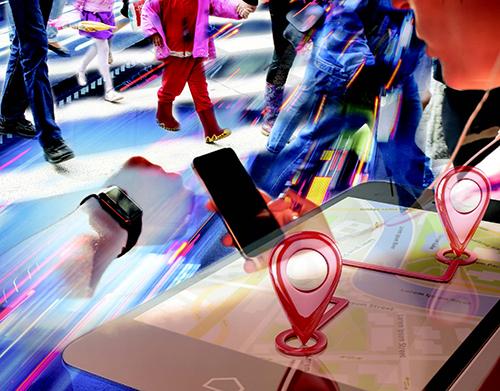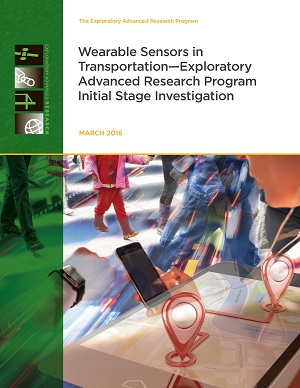Investigating Wearable Sensors in Transportation Research

For decades, the travel diary has been one of the transportation researcher’s most valuable tools. Participants in travel studies use diaries to record where they go, how they get there, and other key information. But the technology of the travel diary, which relies on participants to record their movements and can lack fine detail, is decidedly 20th century.
Wearable sensors have opened up new levels of data granularity for transportation researchers. Wrist sensors, for example, can tell researchers with pinpoint accuracy where participants have been, the routes they’ve taken, and how much time they spend traveling.
“Whereas before we were limited in how we collect data, there are now many more options,” said Eli Machek, a Volpe planner and lead author of a recent investigatory paper on wearable sensors in transportation research. “The bottom line is that use of these sensors holds a lot of promise for transportation agencies at all levels.”
Working on behalf of the Federal Highway Administration’s Exploratory Advanced Research Program, Machek and her co-authors interviewed researchers from federal agencies, local governments, and the private sector to identify the state of the practice for wearable sensors, and challenges in using them for transportation research.
We Have the Technology, But…
Today’s wearable sensors are small, efficient, and accurate enough for certain kinds of transportation research. They’re carried directly on a person’s body, typically as a wristband or jewelry. With widespread use of smartphones, wearable sensors do not themselves need to be complex computers—they can simply collect raw data and transfer it wirelessly to a participant’s smartphone.
 However, research-grade sensors can be prohibitively expensive, particularly for air-quality monitoring. Effective sensors for measuring a participant’s exposure to vehicle exhaust, particulates, and noise pollution are bulky and can require motors. Additionally, environmental sensors cost more because there is little consumer demand for them. For example, individual people cannot do much in the short-term to improve air quality where they live, so there are few people looking to purchase wearable air quality sensors.
However, research-grade sensors can be prohibitively expensive, particularly for air-quality monitoring. Effective sensors for measuring a participant’s exposure to vehicle exhaust, particulates, and noise pollution are bulky and can require motors. Additionally, environmental sensors cost more because there is little consumer demand for them. For example, individual people cannot do much in the short-term to improve air quality where they live, so there are few people looking to purchase wearable air quality sensors.
By contrast, there is great demand for sensors that measure a person’s health because they provide actionable data: If I want to be at a healthy weight, taking this many steps each day can help achieve that.
Institutional Hurdles
Transportation agencies are moving slowly to adopt wearable sensors in their research. As of this research paper’s publication, only one transportation agency—the Nashville Area Metropolitan Planning Organization—had been identified as using wearable sensors to collect data related to health and active transportation.
There are numerous companies marketing wearable sensors to consumers who want to improve their health and fitness. These companies collect data that could be beneficial to transportation researchers, but the report authors found that few of them sell raw data or analyses to researchers. And when such data is for sale, it often comes with high prices that can be out of reach for smaller research projects.
Having great data is one thing; knowing what to do with it is another. Many transportation agencies, particularly at the local level, do not have data science expertise. Robust data storage and analysis are essential to getting the most out of datasets that have previously unseen levels of detail.
Ethics and Privacy
Ethics rules for the sciences were developed around traditional biomedical research, and these rules have not kept up with questions raised by always-on wearable sensors that measure very personal variables. If data are available from existing wearable sensor companies, it may not be useable if research purposes were not clearly included in the terms of service.
Personal datasets inherently come with privacy concerns. To build participants’ trust in the research process, public sector researchers must safeguard personally identifiable information.
Participants’ comfort with sharing information can also depend on demographics and socioeconomics. A technology enthusiast may willingly share information, while someone who is wary of the government may not. One way to overcome privacy concerns over wearable sensors comes back to giving participants the opportunity to improve their lives.
“If you explain the value of the study, people are willing to participate, especially if they can effect change based on the data,” Machek said. “If people see how the data are valuable, they are often willing to participate. Privacy is not insurmountable if you explain what you’re doing up front.”
 Few transportation agencies today use wearable sensors in their research, largely due to privacy and data management challenges. But, the benefits of using fine-grained detail to make the best choices for transportation systems are compelling enough that the authors expect more agencies will overcome these challenges and use wearable sensors in the future.
Few transportation agencies today use wearable sensors in their research, largely due to privacy and data management challenges. But, the benefits of using fine-grained detail to make the best choices for transportation systems are compelling enough that the authors expect more agencies will overcome these challenges and use wearable sensors in the future.
For more details, read the full report: Wearable Sensors in Transportation—Exploratory Advanced Research Program Initial Stage Investigation.
